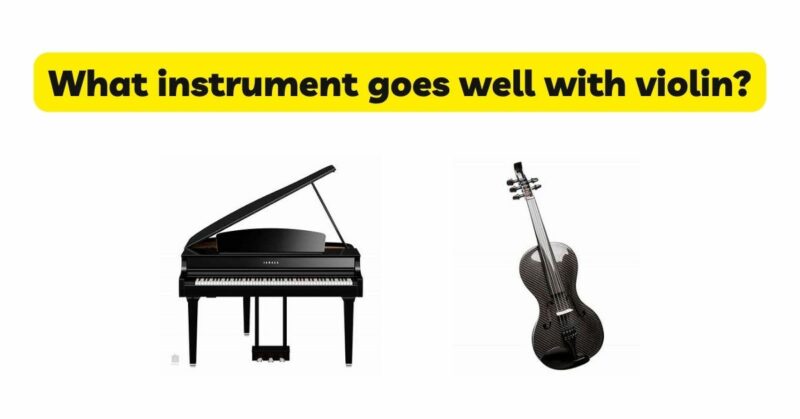The violin is a versatile and expressive instrument that has captivated audiences for centuries. Its rich and melodic qualities make it a natural choice for collaboration with other instruments. Whether in chamber ensembles, orchestras, or small ensembles, the violin can blend seamlessly with a variety of instruments, creating enchanting musical dialogues. In this article, we will delve into the world of musical partnerships and explore the instruments that go well with the violin, examining the unique characteristics and synergies that arise when these instruments combine forces.
The Piano: A Classic Duo: One of the most iconic musical pairings with the violin is the piano. Together, these instruments form a powerful and versatile duo. The piano’s expansive range and harmonic capabilities complement the violin’s soaring melodies. This pairing can be heard in classical repertoire, where composers like Mozart, Beethoven, and Brahms wrote numerous violin and piano sonatas, concertos, and chamber music. The piano’s ability to provide both harmonic support and melodic lines enhances the violin’s expressiveness, resulting in a harmonious and dynamic musical collaboration.
The Cello: A Harmonious Blend: The cello, with its warm and deep tones, is another instrument that harmonizes beautifully with the violin. As both instruments belong to the string family, they share tonal similarities that create a rich and resonant blend. The cello often provides a supportive and grounding foundation, while the violin soars above with its expressive melodies. This pairing can be heard in chamber music compositions, where string quartets or piano trios bring together the violin and cello in intricate and captivating dialogues. Composers such as Haydn, Schubert, and Shostakovich have crafted sublime works that showcase the unique synergy of the violin and cello.
Woodwind Instruments: A Symphony of Colors: Woodwind instruments, such as the flute, clarinet, and oboe, offer a contrasting timbre to the violin, creating a symphony of colors when combined. The ethereal and delicate tone of the flute, the warm and mellow sounds of the clarinet, and the expressive and reedy quality of the oboe provide a captivating contrast to the violin’s brilliance. This combination can be found in orchestral settings, where woodwind sections and the violin section create lush and diverse textures. Additionally, in chamber music settings, ensembles such as the woodwind quintet or mixed chamber groups allow for intricate and intimate collaborations between the violin and woodwind instruments.
Brass Instruments: Power and Majesty: Brass instruments, such as the trumpet, French horn, and trombone, bring a sense of power and majesty to any musical ensemble. When combined with the violin, they create a striking contrast between the brilliance of the violin and the boldness of the brass. This pairing can be heard in orchestral works, where the violin section interacts with the brass section to create moments of grandeur and intensity. Composers like Tchaikovsky, Mahler, and Copland have masterfully integrated the violin and brass instruments in their symphonic compositions, highlighting the dramatic and expressive possibilities of this combination.
Percussion Instruments: Rhythm and Pulse: The addition of percussion instruments to the violin can infuse a piece with rhythmic vitality and energy. Instruments like the timpani, snare drum, and cymbals provide a rhythmic foundation and add dynamic accents to the violin’s melodies. This combination can be found in orchestral works, where the percussion section works in tandem with the violin section to create a driving and rhythmic momentum. It can also be explored in contemporary and experimental music, where violinists collaborate with percussionists to create innovative and engaging soundscapes.
Guitar and Harp: Strings in Harmony: The guitar and harp, both stringed instruments like the violin, offer a natural kinship. The guitar’s versatility and rhythmic capabilities, along with the harp’s ethereal and resonant qualities, create a beautiful blend with the violin. This combination is often found in chamber music settings, where small ensembles bring together these instruments to create intimate and enchanting performances. The interplay between the plucked strings of the guitar or harp and the bowed strings of the violin can result in mesmerizing and delicate musical conversations.
Conclusion: The violin’s ability to harmonize with various instruments opens up a world of musical possibilities and collaborations. Whether it’s the classic partnership with the piano, the warm blend with the cello, the contrasting colors of woodwind and brass instruments, the rhythmic energy of percussion, or the kinship with guitar and harp, the violin finds its voice in dialogue with other instruments. Exploring these musical partnerships not only expands the repertoire for the violin but also enriches the musical experience for both performers and listeners. As a violinist, embracing these collaborations allows you to unlock new expressive possibilities, creating breathtaking harmonies and captivating performances.


